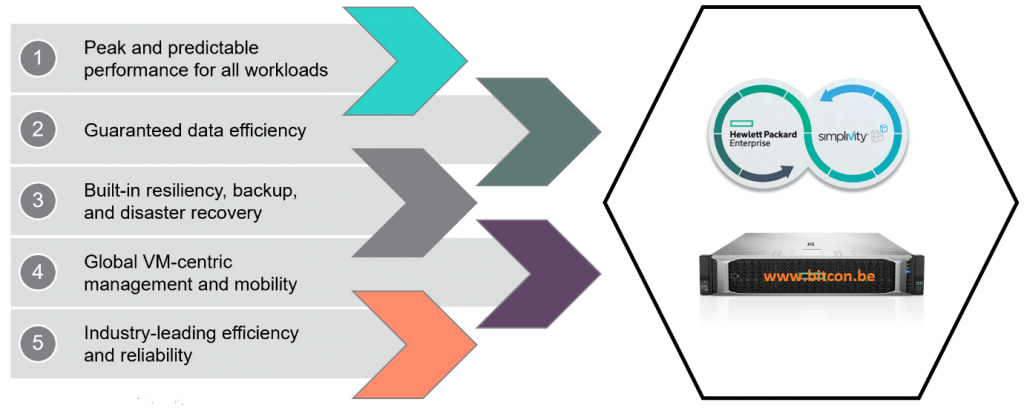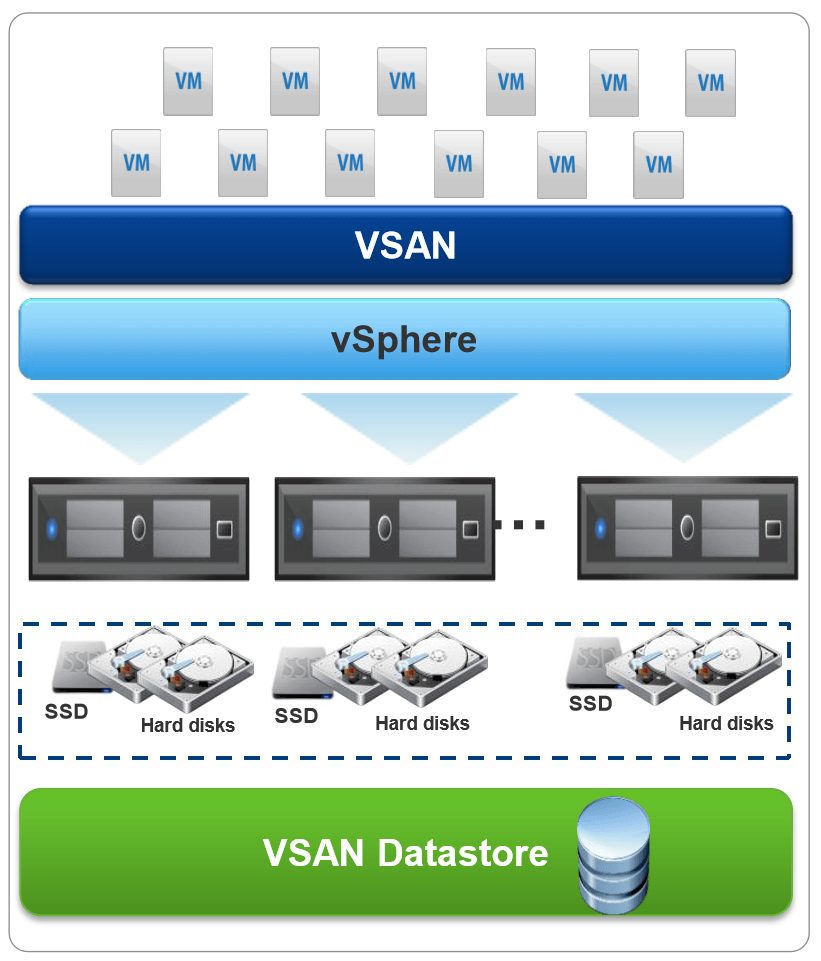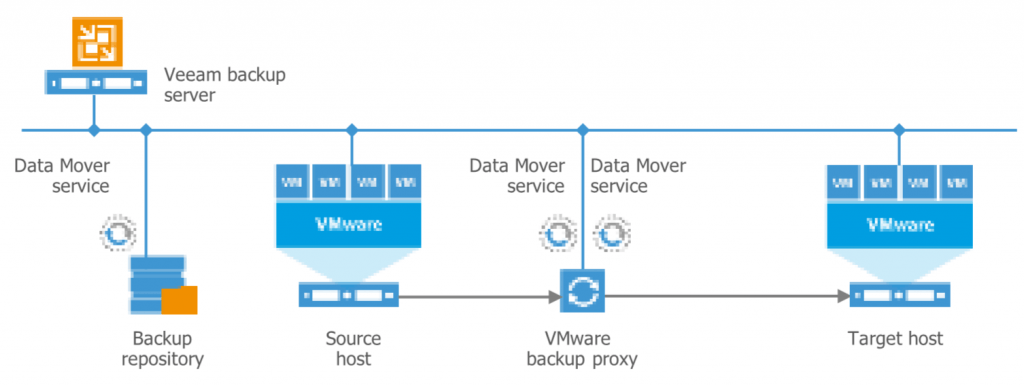I got a lot of messages and meeting requests since the official EOL announcement of HPE StoreVirtual VSA. That much that I want to write this article to clarify all options out there. It looks complicated, but it isn’t…
First define for yourself (or your customer) what you really need. High Availability or Disaster Recovery? RPO (Recovery Point Objective) of 0, or is a few minutes acceptable? A hyperconverged experience, or do you want a ‘physical’ storage solution in your server room to satisfy the server, storage and networking experts (aka traditional IT)? Data protection on infrastructure, server or application level? Questions enough to make the right decision.
HPE SimpliVity
When I meet a typical StoreVirtual VSA customer, I will lead always with HPE SimpliVity.
Why? Because there are a lot of similarities (more you can imagine) between the 2 products.
Although HPE never called the VSA a hyper converged product (missed opportunity), it actually is one… Server and storage combined in 1 appliance for a higher efficiency and lower TCO. Simplivity spreads blocks of data (after deduplication and compression) on 2 separate nodes in the cluster… What does Network RAID 10 from VSA? If you don’t know, read my (still popular) article explaining what NetworkRAID10 actually does… Yep , the same.
VSA delivers a shared storage platform to your server. What does the OmniStack Data Virtualization Platform? Indeed… VSA runs on VMware and Hyper-V, Simplivity too…
Now why would you prefer Simplivity? Well that is very simple… It does more compared to the VSA… It does deduplication and compression inline, guarantees performance, gives you 1 management interface, and gives you a better data protection. When I do a demo for a customer who suffered a CryptoLocker attack for instance, showing him his fileserver can be online again in 1 minute, believe me it is a no-brainer…

The strength of the Simplivity solution are the 5 above mentioned features in the solution you will get all at the same time. No choice to make. And verify that the other similar hyper converged solutions can do the same… Believe me, not all 5 of them together at the same time… Use cases enough to refer to.
Want more info? Try to attend on of my sessions on Simplivity and become a guru in positioning Simplivity…
HPE Nimble
Not all companies buy their server and storage infrastructure all at the same time. Most customers have various generations of servers implemented in a staged way… There it will be a bit harder to position Simplivity since you are buying an all-in-one solution replacing server and storage at the same time.
If you need specifically a storage solution to connect to their existing servers (which are not end of life/support yet), that is on top very efficient and can deliver performance and capacity in a scale-up and scale-out way, HPE Nimble is the way to go.

The Nimble portfolio consists of All-Flash (AF series) and Adaptive (HF series) models delivering all-flash performance, which is very simple to implement and maintain, delivering fully featured data services in a very efficient way by using as well inline deduplication and compression.
And now with the latest release of NimbleOS 5.1 it delivers synchronous replication as well. More information in other articles on my website.
Don’t forget to mention that Nimble also features HPE InfoSight delivering a cloud-based monitoring platform delivering AI-based cross-stack analytics. This platform will make the life easier of the IT team delivering predictive support. HPE support will call you instead of you calling them. Watch a demo of InfoSight and you will be convinced.
VMware vSAN
VMware vSAN is also a valid option when you compare features: change local storage into shared storage for your virtualized environment. When sizing, it is important to follow the HCL (Hardware Compatibility List) from VMware, but this is rather easy when using the predefined VSAN Ready Nodes from HPE. There is also a very easy to use VSAN Sizer available.

A bit tricky will be those implementations with 2 server rooms where you will need 6 nodes with VSAN to get the same resiliency compared to a 2-node VSA solution with a quorum arbiter. VMware VSAN supports 2-node deployments, but this is positioned for ROBO deployments only.
Veeam Backup & Replication
Veeam is widely known for its backup application on initially virtual but now physical environments as well. However, the official name of the product is ‘Veeam Backup and Replication’. Indeed, it can also replicate VM’s to another host, onsite or offsite with a WAN in between, giving you protection on VM level.

Since most customers have Veeam deployed, you might consider using the replication feature of Veeam as well. Know that you might want a dedicated replication network for performance reasons when the VM count is rising. Definitely follow the best practices from Veeam there.
In the future, you can even expect the replication interval to shrink when Veeam has implemented CDP (Continuous Data Protection). This could mean going from an 5 minute interval to mere seconds.
Also, this will work fine in a small to medium environment. If you have a larger environment and you also want to dynamically manage this you should look to VAO (Veeam Availability Orchestrator) that will solve your needs.
HPE MSA
Most VSA customers love the synchronous replication of the VSA offering RPO = 0. At that moment MSA was never an option since it does asynchronous replication only…

However, I have a lot of customers that deployed the VSA solution to virtualize their local storage inside their hypervisor servers into a shared storage platform, and where those servers are installed in the same server room. So, no 2 server rooms.
Or when you start asking them a bit further about their data availability requirements they really don’t need an RPO of 0 or 6 nines of guaranteed availability at the end… An RPO of a few minutes is often acceptable for a much lower price…
At that moment HPE MSA is a good and valid option. 2 controllers to protect against planned and unplanned downtime, high performance with the caching and tiering mechanisms (go for the MSA 2052 model which includes all required licenses) and a variety of connectivity (FC, iSCSI and SAS). What else do you need more from a storage solution with a proven track record of more than 10 years?
Application level replication
If you want high availability on application level, you might consider techniques lihe Microsoft Exchange DAG (Database Availability Groups) or Microsoft SQL Replication. Also Oracle deliver same mechanisms to replicate databases…
Won’t go too much into details here since this is independent of the hardware underneath the running software and applications, Google is your friend for more information here: SQL – Exchange – Oracle
Side note: I do not dive deeper in another great storage platform called HPE 3PAR since this is positioned above the typical requirements a VSA customer is looking for, however who knows what the future may bring.
You see? Options enough, depending on those little differences in requirements of your specific environment. And if it is still not clear for your situation, feel free to contact me and we will work out a solution together…
Be social and share
